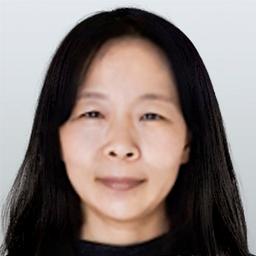While watching television, 70-year-old South Korean woman Lee Young-ran suddenly noticed that the numbers in the subtitles were surprisingly clear.
She could hardly believe it, thinking, “This can’t be real. Am I imagining things?”
Her eye health had gradually deteriorated with age, with her having suffered from various conditions such as glaucoma, macular degeneration, and cataracts for over a decade. In recent years, she had almost lost her vision to the point of finding it difficult to open her eyes. Her surroundings often appeared dark, with an extremely narrow field of vision of about 45 degrees. The TV was consistently blurred, and even people’s faces at a close distance were indiscernible. Daily activities had become very inconvenient, and she endured considerable hardship due to her visual impairments.
“I need to take a closer look.” Ms. Lee walked up to the television, trying to confirm the numbers she had just seen.
“Oh my goodness! The numbers I saw from a distance earlier were actually correct!” She was astonished.
She quickly double-checked from a distance a few more times, and sure enough, she could now see the numbers clearly from afar.
“It’s truly unimaginable. How did I recover so well in just four or five months?” she thought excitedly.
Falun Gong
It was late 2020, and Ms. Lee’s husband had recently passed away. She felt a profound sadness, rarely leaving her home, and her emotions were at rock bottom. One day, a long-lost friend called and introduced her to Falun Gong, a beneficial qigong practice. The friend suggested she give it a shot. Intrigued by the concept of qigong, Ms. Lee gladly accepted the invitation.Upon hearing that practicing Falun Gong involved physical exercises and reading books for spiritual cultivation, Ms. Lee grew quite concerned. She thought, “Will my eyes be able to handle reading?”
Despite not having much hope, she decided to try it and attended the nine-day Falun Gong workshop.
She earnestly listened to the lecture videos by the founder of Falun Gong, even though she could not clearly see the master’s face.
“It’s unbelievable that such a cultivation practice exists! Practicing truthfulness, compassion, and forbearance is truly wonderful!” she exclaimed. After participating in the nine-day workshop, she decided to commit to the practice.
After the workshop, she committed to reading a book titled “Zhuan Falun,” the core text of Falun Gong. Word by word, she diligently and slowly read through the book, covering as much as she could each day. The more she read, the more she desired to read.
At the same time, she persisted in practicing the exercises every day. During the practice, her body exhibited various reactions. Sometimes, she felt energy continuously swirling on the top of her head; other times, she sensed a cool breeze releasing from her body, and occasionally, she experienced a warming sensation.
The Recovery
In her 40s, Ms. Lee suffered from severe oophoritis, inflammation of the ovaries. Despite recovering with treatment, her overall health declined over time, leaving her physically weak. Since then, she has had a pessimistic outlook on her health. In her 50s, she went so far as to cancel various health and retirement insurances, convinced she would not live for long, viewing insurance payments as a waste of money.After that, she became afflicted with diabetes, high blood lipids, and various eye diseases, leading to a further decline in her health.
Ms. Lee expressed that with a notable improvement in her vision, she gained optimism and confidence, experiencing a sense of ease. She also dedicated herself more to the practice, resulting in a continuous improvement in her overall health.
“Previously, I could barely open my eyes. Now, not only can I open them wide, but my field of vision has also widened significantly. I can freely read, watch TV, and even drive my grandchildren to tuition classes at night,” she said.
After practicing for over two years, not only has her vision recovered, but other symptoms have also gradually improved. Previously, she had a low appetite, poor digestion, and frequent diarrhea. Even a short trip to the nearby supermarket would leave her exhausted.
“Nowadays, I’m full of energy, moving briskly as if I could fly,” she proudly said. “My appetite has also increased significantly; I can eat anything now, and everything digests well.”
Furthermore, her immune system has seen significant improvement. In the past, even a minor skin injury would quickly lead to infection, and despite medical treatment or the application of ointment, the recovery was slow. “Now, I don’t even need to apply ointment for minor cuts; it can heal quickly,” she remarked.
The chronic sinusitis that had long tormented her has also disappeared. Previously, she struggled with a constant runny nose, needing to repeatedly blow her nose and spit out the mucus that flowed backward into her mouth, causing significant distress.
Notably, her interpersonal relationships have undergone significant changes.
In the past, she was more grudge-holding, and even though she would often put on a smile during conflicts, behind the scenes, she would harbor complaints and curses. Nowadays, she actively works to shake off these negative thoughts.
She shared that she had a major disagreement with a friend on one occasion. Struggling against the aversion and resentment toward her friend, she consciously reminded herself to adhere unconditionally to the principles of truthfulness, compassion, and forbearance. Consequently, the feelings of discontent quickly dissipated.
Meditation’s Positive Impact on Glaucoma
Glaucoma is a group of eye conditions that damage the optic nerve, and optic nerve damage is often associated with increased intraocular pressure. It is a leading cause of blindness in individuals aged 60 and above. Currently, there is no cure for glaucoma in modern medicine.Falun Gong’s Remarkable Health and Fitness Benefits
In 2020, a study involving over 1,000 Taiwanese Falun Gong practitioners was published in the international journal Health Behavior and Policy Review. The findings revealed that Falun Gong practitioners aged 65 and above demonstrated significantly higher scores in all eight physical and mental health indicators compared to the general population. Falun Gong practitioners scored substantially higher than the general population in six of the eight indicators. Particularly, they excelled in the “physical health” indicators and “role limitations due to emotional issues.”The study also investigated the occurrence of chronic diseases, including heart disease, diabetes, lung conditions, and high blood pressure, among Falun Gong practitioners. After practicing, 70 percent to 89 percent of individuals experienced improvement or recovery from these conditions.





